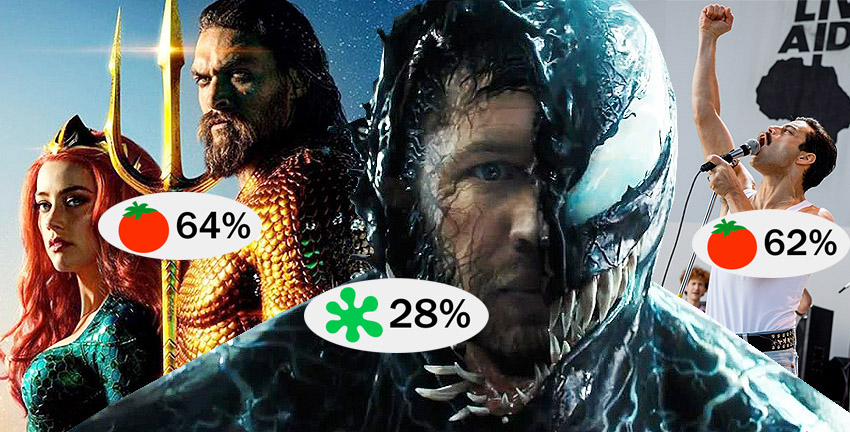
Many would argue that a review can make or break a movie and it's very true that studios have become slaves to that almighty Rotten Tomatoes score of late with everyone aiming to get that "certified fresh" badge to trumpet their film (oftentimes now used directly in TV spots or trailers), which would presumably sell the movie to casual filmgoers and fanatics alike. However, the reliability and metric of this system is questionable at best and has proven not to be a measure of a film's actual quality, but rather a cumulative percentage from accredited critics (normally totaling between 190 – 250 reviews), leading to one of three ratings; fresh, rotten or the coveted "certified fresh" (a film that scores a 75 percent or higher with at least 40 reviews). Unfortunately, this measure is hardly the measure for success or quality. Fresh (or "certified fresh") doesn't mean good box office nor does rotten mean poor box office. In terms of quality, we're talking about 250 reviews from a planet of more than seven billion people that are writing about art, not the best toothbrush on the market (and, full disclosure, at least two of our own reviewers submit to RT, contributing to that "score" regularly). With all that said, how is it that two movies, each a risk given their unproven box-office mettle (i.e. first solo features for both characters), managed to outpace negative critical reviews and become box-office behemoths in the face of presumably tough competition and, ultimately, how much does a critical consensus matter in terms of not only success, but quality?
From the initial announcement of a VENOM movie (including a rumor started that it would be rated R), people were doubtful, albeit interested, in seeing a Spider-Man spinoff film starring a villain. After all, Sam Raimi’s SPIDER-MAN 3 already attempted to adapt the slobbering, toothy baddie with middling results, but that didn't diminish the hype in seeing him come to life. The odds tipped in the film’s favor with the hiring of Tom Hardy, an actor who has gained notoriety with critics and fans alike, due to performances in a number of notable films, including THE DARK KNIGHT RISES, THE REVENANT and MAD MAX: FURY ROAD. Ruben Fleischer took on directing chores, although he was more of a competent choice than an inspired one. Fleischer delivered on the zany, action-heavy genre with ZOMBIELAND (and is currently filming its sequel), but hadn’t exactly left a discernible mark on cinema. Michelle Williams was added as the love interest, while Riz Ahmed was cast as the main villain. Both actors had garnered critical acclaim in recent years (Williams was most recently nominated for an Oscar for her work in MANCHESTER BY THE SEA and Ahmed took home an Emmy for his work on HBO’s The Night Of), which added some extra clout to the supervillain pic. Early trailers sparked curiosity and the first look at the full VENOM character seemed to arouse interest, even if very little else about it looked particularly new or exciting.
Hopes weren’t exactly high and speculation that the film would not only be terrible but would also flop at the box office began to spread like Twitterfire. This turned into presumptions about Sony’s “Spider-Verse” universe of films failing to launch with many online critics and bloggers alike predicting complete and utter disaster. Early critic screenings were held, and a few leaked their thoughts on social media, one even calling it “Catwoman level bad” which is in reference to Warner Bros. first attempt at a solo CATWOMAN film in 2004, which starred Halle Berry and Sharon Stone and was, by all accounts, a critical and financial failure. This early break-the-embargo word of mouth sharing felt like part of a sinister agenda to simply see something fail, rather than see what happens. After all, there’s no fame or glory in holding one’s tongue when you can spike the fervor of rabid fans, right?
Reviews began rolling in and it was more of a mixed bag than a total wash, but on the spectrum of Rotten Tomatoes, VENOM appeared to be a bad movie or “rotten” as the simplistic green splatter would have you believe. But something happened that first week of release; people turned out in droves, giving the film an opening domestic take of $80 million, overperforming in both foreign and domestic markets. The final tally, thus far, sits at $213 million domestic and $642 million foreign, totaling $855 million globally. That’s no minor hit, that’s a freight train at top speed. At a budget of $100 million, VENOM is an absolute success and bodes extremely well for Sony’s desire for a Spider-Man spinoff universe (provided people turn out for their lesser-known characters, which are arguably a bigger gamble than Venom).
So, what happened? Why was VENOM such a huge hit, even after critics shredded it? Are critics out of touch? Are audiences just hate-watching a film to a near $1 billion global take? Are audiences just “stupid” and have no awareness between what’s good or bad? Or, are audiences merely responding to what appeals to them, rather than what less than one percent of the world population thinks? Certainly, all of those factors play into the equation in some regard, but ultimately what many early predictions failed to grasp was the simple popularity and visibility of Venom as a character. Since his introduction in The Amazing Spider-Man #300 in 1988, Venom has become a staple Spider-Man villain, helping to sell any and all comics he appeared in before getting his own titles, including Lethal Protector, which the VENOM film is partially based on. His popularity among comics readers, as well as the general public, grew to mass appeal. From action figures, cartoon appearances, video games, apparel, etc., Venom, like Deadpool, another underestimated popular character, had wings that would make Red Bull proud.
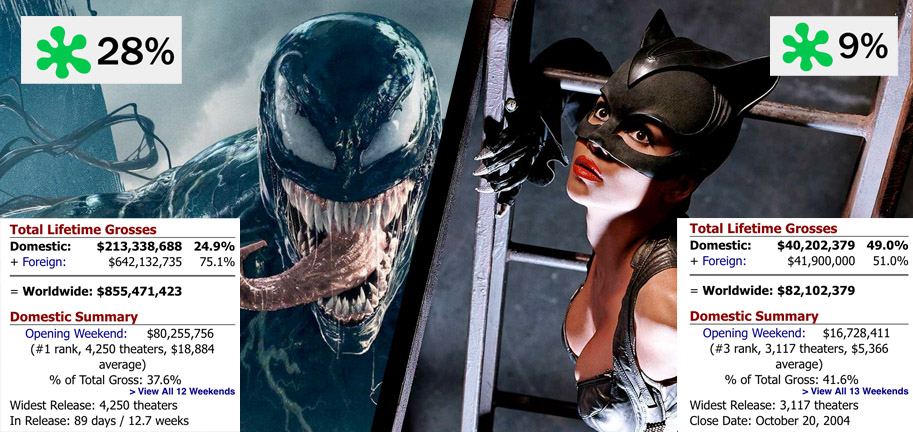
As for the movie being “Catwoman level bad”, well, that’s part opinion and part complete hyperbolic fiction. CATWOMAN raked in a paltry $82 million worldwide for its entire run on a budget of $100 million. By contrast, VENOM pulled in that amount during its opening weekend, finishing (thus far) at $855 million. The argument, of course, is that the quality of the film has nothing to do with box office. But, is that really true? Are we saying that people just pay for terrible films over and over again? The quickest response to this is, of course, Michael Bay’s TRANSFORMERS films, which traditionally grossed big, but were hammered critically. Like VENOM, however, I think this is where many have lost sight of the universal appeal and genuine enjoyment that these characters bring to the big screen. If a film doesn’t have “quality” then folks certainly wouldn’t turn out for it. In the end, is the quality determined by critics or by audiences?
The irony about Michael Bay’s TRANSFORMERS is that his last (and fifth) film in that series, TRANSFORMERS: THE LAST KNIGHT, ended its worldwide run with $605 million and a fifteen percent rotten score on Rotten Tomatoes, while the newest iteration of the franchise, the spinoff film BUMBLEBEE, has pulled in only $157 worldwide thus far with an overwhelmingly positive rating, sitting at ninety-three percent “fresh” on Rotten Tomatoes. With a budgetary difference of $85 million between the two, that’s not a good sign and again begs the question in regard to what (and who) exactly determines “quality” and what that means for box office success. I’m sure Paramount would gladly trade some RT points for some box office dollars in BUMBLEBEE's case.
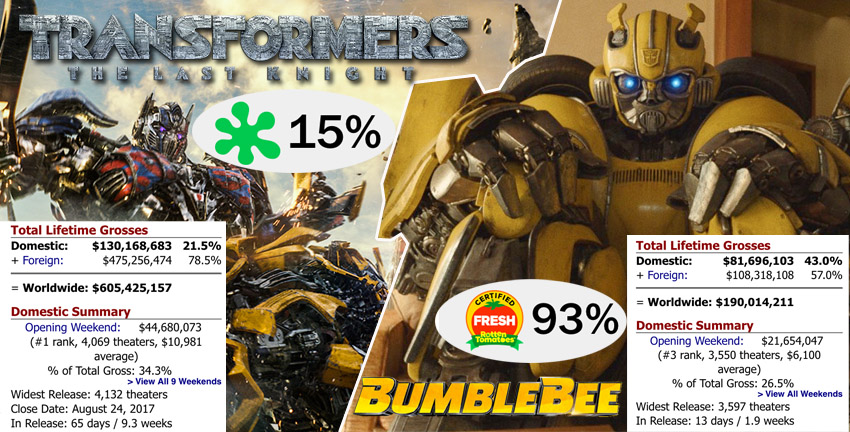
BUMBLEBEE, for all its expectations in hitting all the right notes in terms of box office appeal (Christmas season film, Hailee Steinfeld appeal, John Cena appeal, Transformers brand appeal and easy-to-digest family film appeal), was expected to be the big winner of the holiday season at the box office. The only other competition was a way-late-in-the-game sequel from Disney with MARY POPPINS RETURNS (a tough sell for young male audience members, but mass appeal to female audiences), another film that many blindly expected to be crowned box-office king (or queen) over the holidays. Surely, those would fare better than some DC movie about a superhero that talks to fish. A comic-book movie called AQUAMAN with a half Hawaiian/half German/Native American lead? Why, that would flop like a fish without air at the box office in comparison to a cute robot movie with explosions and a singing-dancing nanny played by Emily Blunt, right?
Reviews for AQUAMAN (full disclosure, I loved the film) were middling to good, leaving the film at sixty-four percent “fresh” (out of 297 reviews in a world population of more than 7 billion). Unlike VENOM, AQUAMAN at least had a “fresh” rating (although not “certified fresh”), which could certainly sway those that turn to such places for movie recommendations to see the film, but ultimately AQUAMAN has proven to have way more than one-and-done viewing power and the most powerful form of advertising (word of mouth) has already taken hold. This is a movie with serious (sea) legs, earning $67 million its opening weekend (ironically, BUMBLEBEE’s current domestic cume) and, as of this writing, is sitting at $216 million domestic and more than $800 million worldwide, heading for the first DCEU film to cross the $1 billion mark and first DC movie in general to hit that milestone since Christopher Nolan’s THE DARK KNIGHT RISES. (By contrast, MAN OF STEEL ended its worldwide run at $668 million, BATMAN V SUPERMAN at $873 million, SUICIDE SQUAD at $746 million, WONDER WOMAN at $821 million and JUSTICE LEAGUE at $657 million).
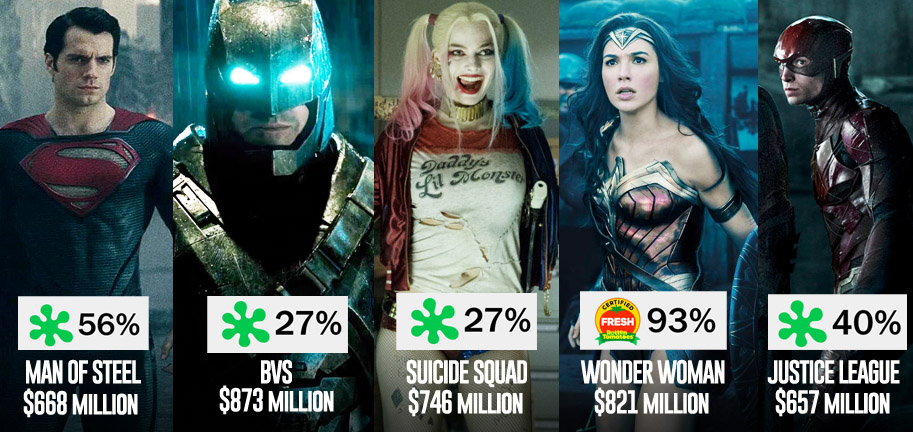
So, what happened? Two “certified fresh” franchise films vs. an untested water-borne superhero and AQUAMAN swims to the top. While AQUAMAN has been around as a character since 1941, his popularity has never reached the heights of The Trinity (Batman, Superman, Wonder Woman). Sure, Momoa already had a blink-and-miss-it introduction in BATMAN V SUPERMAN and a side role in last year’s JUSTICE LEAGUE debacle, but he was hardly a box office draw based on name alone. The supporting cast, however, was not to be dismissed; Nicole Kidman, Amber Heard, Willem Dafoe, Patrick Wilson, Temuera Morrison, Dolph Lundgren, Yahya Abdul-Mateen II, Michael Beach, Ludi Lin, Randall Park and Graham McTavish. Not a bad line-up when attempting to appeal to those that may be on the fence about an underwater superhero movie starring a mostly unknown lead.
While casting certainly makes a difference in what people choose to see, another aspect that sorely needed attention with a film like AQUAMAN was the creative direction. Enter James Wan, who made a name for himself early on with horror flicks like SAW and THE CONJURING films, but later proved his action chops with his entry in the THE FAST AND THE FURIOUS franchise with FURIOUS 7. Wan entered into AQUAMAN with a clear vision of what he wanted to make (an adventure film in the tune of ROMANCING THE STONE meets INDIANA JONES) and paid very careful attention to the roots of the comic he was adapting, providing a bevy of visuals, characters and iconic moments that translate directly from the page to the screen. Rather than subvert what he was adapting, however, Wan embraced it completely, taking the most ridiculous aspects of AQUAMAN and turning them on their head to make them cool. It was a gamble, but obviously one that paid off.
Aside from the cast, direction and visual punch, the story was something that would have to keep people coming back for more and AQUAMAN offers up much of the familiar beats we’re accustomed to, but inside a whole new underwater universe. The themes of love, destiny, sacrifice and hope are abundant here and presented in a way that’s inspiring and cheer-worthy. Visually, the film has punch (IMAX is the most satisfying way to see it by far), but ultimately audiences seemed to respond to the themes that are so often washed over in superhero films, mainly those of love and destiny. Audiences love an underdog. They love seeing someone rise above their station and become something better and, like everyone on a dating app, finding true love. Sound corny? Maybe it is. And maybe that’s what audiences want. Maybe it’s what they need, more so than song-and-dance numbers or smash-em-up robots (which isn't to say those films don't have heart, but AQUAMAN seems to be winning folks over emotionally and financially in that regard). At the end of the day, we go to the movies to be entertained, to be moved, to be inspired. That doesn’t mean audiences can’t handle more complex fare, it simply means that they value entertainment that feeds and sustains the aspects of humanity that we all toil with (and often strive for). While that doesn’t mean they’re looking for a lost trident to rule a fictional Atlantis, the themes are very much relatable. For that alone, AQUAMAN had universal appeal, even if it was too cheesy or playful for some (particularly those that are still holding onto the bleaker version of the DCEU).
We also shouldn’t discount the appeal to women when it comes to AQUAMAN. Having visited the set, I saw firsthand what Jason Momoa’s mere presence does to women and sitting next to women in a theater when the trailers rolled out let me know that AQUAMAN wasn’t just fueling teenage males (or 40-year-old males, for that matter). Indeed, a topless Momoa (or spandex-covered Amber Heard to keep things equal) played a good role in sex appeal for moviegoers. In fact, some women are getting cringe-worthy about what they see in Momoa and what they'd let him do to them (and people got offended by MovieHotties? Really?). However, it’s not all about sex. I sat next to a group of teenage girls watching AQUAMAN in IMAX and marveled at how into the film they were. Fist-pumping, crying, laughing and cheering at all the various beats (especially that underwater kiss and happy reunion at the end). Simply put, AQUAMAN, despite what some may label as a silly superhero movie for boys, wasn’t that at all. It’s a movie that appealed to a wide variety of people and enough that they’re going back for multiple viewings and bringing family and friends with them. Does that not speak of quality?
And while we're on the subject, let's not forget BOHEMIAN RHAPSODY. Based on the life of the late singer and frontman of Queen, Freddie Mercury, the music-themed biopic was received as mostly lukewarm to critics, hovering at sixty-two percent "fresh". Many critics of the film found it to be "safe" or "basic" and lacking the deep dive into the sex, drugs and rock and roll fueled world that typically pervades these types of films (see: Oliver Stone's THE DOORS). However, the Bryan-Singer directed flick sang to audiences, who flocked to the film, making it the highest-grossing music biopic of all time, raking in more than $700 million worldwide. With Singer's name being stigmatized over his personal life and even being fired from the film at one point, the film already seemed to be in hot water. Reports of arguments with star Rami Malek also added trouble for the film, but ultimately audiences bypassed the behind-the-scenes drama and infighting to watch the story of one of the greatest singers (and one of the greatest bands) in a crowd-pleasing fable. I guess you could say they turned up just for the music, but wouldn't it be cheaper to just buy a greatest hits album instead?
So, where does that leave us in understanding the success of films like AQUAMAN, VENOM or BOHEMIAN RHAPSODY when critical reviews would have us believe they’re less-than-stellar in terms of the “certified fresh” crowd? Have critics lost their touch? Have audiences lowered their standards? I don’t think either is true, but some perspective helps. Film criticism is an important trade and the best of it helps us understand films better and opens up dialogue about them. The better part of my life has been spent talking, reading or writing about movies and I’m grateful for the perspective I’ve gleaned from that. However, it’s also true that we can get locked into this new percentage culture that relegates a movie down to a number, which represents less than one percent of the actual movie-going audience. Thankfully, that measure isn't dictating success or failure, but that also presents the issue of what it's actually accomplishing for anyone.
For those not ingrained in the culture of movies (i.e. the casual moviegoer), sites like Rotten Tomatoes or Metacritic can represent a simple yes-or-no answer to whether they should see a movie. The problem, however, is that movies aren’t toaster ovens. Movies are art and as such require a more personal approach than a basic “product review”. The best advice for anyone that’s looking to use a critical guide to help decide if they should see a movie or not, is to find critics that typically align with their tastes, rather than trust a catch-all score. Finding a critic that has similar taste is a far better measure to understanding whether or not you should see a particular film, although the best measure is simply to see what you want regardless of critical consensus or individual review. There are movies rated “rotten” that I love and movies “certified fresh” that I loathe. Does that mean that sites like Rotten Tomatoes are bad or evil or misleading? No. It just means that they simply aren't the last word on what's considered good or bad, as a multitude of factors go into that, starting with one simple thing; your own opinion.
In the end, we are our own critics and the success of AQUAMAN, VENOM and BOHEMIAN RHAPSODY show the power of that. Everyone determines what a quality film is by themselves. There is no definitive yes-or-no measure dictated by any metric-ruled site, let alone an individual review, that will give you that answer. It's ultimately up to the audience to decide and the success or failure (as well as the measure of quality) of any film is governed by them. Neither AQUAMAN, VENOM or BOHEMIAN RHAPSODY are "certified fresh" and none of them may take home a golden trophy to "prove their worth". But, when it comes time to pop in a movie to watch again and again, people will reach for the ones they deemed worthy of their time and money, rather than ones deemed good or bad by a fruit-emoji percentage.
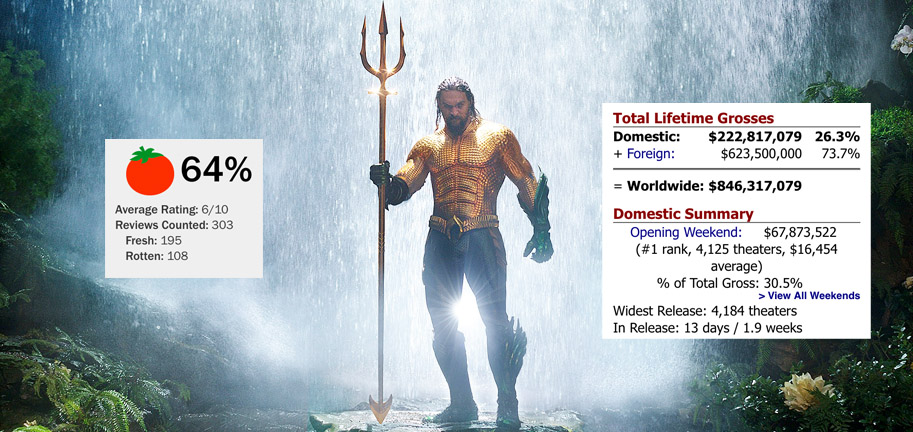




















Follow the JOBLO MOVIE NETWORK
Follow us on YOUTUBE
Follow ARROW IN THE HEAD
Follow AITH on YOUTUBE